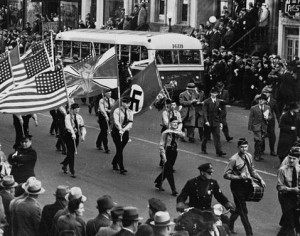Overview
The 1940s witnessed the worst military conflict in world history. Out of more than 70 million combatants from 70 different countries, the editors at Digital History estimate about 17 million dead, including about 400,000 American military personnel out of more than 15 million in uniform. All of those figures exclude other types of casualties (such as wounded) and also civilian deaths, which vary widely by source, but which probably exceeded 50 million overall, included nearly 6 million European Jews in Nazi death camps. There had been plenty of warnings of impending conflict, but nothing that could have anticipated this type of carnage. Americans seemed especially determined to learn lessons from this immense bloodletting. The United States was not really isolationist in the years between 1919 and 1941, but there had been a palpable sense of disconnection with the rising tide of problems in Europe and Asia. As Russell Baker put it in his memoir, Growing Up, “worlds were burning, but they seemed far away.” Baker remembers his family mocking the  “sausage-stuffers” of the German American Bund (pictured to the right, marching in New York in 1939). His mother memorably claimed in 1939, while they lived in Baltimore, that “This is England’s war. Let England fight it.” Yet once the Japanese launched a surprise attack on Pearl Harbor on December 7, 1941, such cautious sentiment shifted dramatically. Under the leadership of Franklin Roosevelt, the United States quickly moved to engage in the global conflict on multiple fronts, not only in the Pacific against Imperial Japan, but also in support of the Allied powers in the European fight against Nazi Germany and Fascist Italy. The war turned much of the politics of the previous generation upside down. The US was now allied with the Soviet Union. American men and materials were being rushed overseas. Women were working and contributing mightily to the war effort on what was called the “homefront.” There were also periods of terrible panic, such as the decision to relocate Japanese and Japanese-Americans on the West Coast to internment camps. Throughout this turbulent period, however, the United States continued to lead what many were already calling the “united nations” against a range of totalitarian threats. There was still some signs of economic, social and racial troubles at home, but the national focus had generally moved away from the kind of domestic concerns that had dominated during the Great Depression. Military victory came in the summer of 1945, but not before a new U.S. president, Harry Truman, felt compelled to authorize the dropping of two atomic bombs on the Japanese cities of Hiroshima and Nagasaki. The world’s most destructive war had finally produced the world’s most destructive weapon. The atomic age proved difficult for policymakers in the Cold War era to handle –though somehow, they did. As it began, however, Russell Baker reported that he and his family were utterly unaware that “anything very extraordinary had happened.” Instead, the young naval aviator-in-training went home, a veteran but not a combat hero, and returned to a new life, like millions of other Americans in the 1940s, in the shadow of terrible war, but still proud of the nation’s sacrifices for global freedom and full of hope for a better future.
“sausage-stuffers” of the German American Bund (pictured to the right, marching in New York in 1939). His mother memorably claimed in 1939, while they lived in Baltimore, that “This is England’s war. Let England fight it.” Yet once the Japanese launched a surprise attack on Pearl Harbor on December 7, 1941, such cautious sentiment shifted dramatically. Under the leadership of Franklin Roosevelt, the United States quickly moved to engage in the global conflict on multiple fronts, not only in the Pacific against Imperial Japan, but also in support of the Allied powers in the European fight against Nazi Germany and Fascist Italy. The war turned much of the politics of the previous generation upside down. The US was now allied with the Soviet Union. American men and materials were being rushed overseas. Women were working and contributing mightily to the war effort on what was called the “homefront.” There were also periods of terrible panic, such as the decision to relocate Japanese and Japanese-Americans on the West Coast to internment camps. Throughout this turbulent period, however, the United States continued to lead what many were already calling the “united nations” against a range of totalitarian threats. There was still some signs of economic, social and racial troubles at home, but the national focus had generally moved away from the kind of domestic concerns that had dominated during the Great Depression. Military victory came in the summer of 1945, but not before a new U.S. president, Harry Truman, felt compelled to authorize the dropping of two atomic bombs on the Japanese cities of Hiroshima and Nagasaki. The world’s most destructive war had finally produced the world’s most destructive weapon. The atomic age proved difficult for policymakers in the Cold War era to handle –though somehow, they did. As it began, however, Russell Baker reported that he and his family were utterly unaware that “anything very extraordinary had happened.” Instead, the young naval aviator-in-training went home, a veteran but not a combat hero, and returned to a new life, like millions of other Americans in the 1940s, in the shadow of terrible war, but still proud of the nation’s sacrifices for global freedom and full of hope for a better future.
Online Textbook Resources
World War II from Digital History (Mintz and McNeil)
Early Cold War from Digital History (Mintz and McNeil)
Selected Timelines
World War II (National Geographic)
Featured Videos

Yushun Wang
I did not find too much connections between between Growing Up and World War II: apparently, Russell spent his whole military career domestically. Even though he wanted to join the battle to Japan mainland, the war had already been ended by nuclear bomb. Maybe it is a scene to some of American veterans in World War II: they were well prepared for the war but the war had finished before they really joined into the war.
(There may be some reasons about the date. Russell, if I recall it right, joined in Navy in 1942. Before he finished his training, which maybe last for 1 or 2 years, the most bloody battle in Pacific had ended like Midway Island. After those several major battles Japanese Navy had lost most of their power and they had to use “kamikaze” strategy.)
It was not bad to Russell. And, it is also in these five chapters (14 to 18), we get to know more about Russell, instead of his mother. His mother was a very powerful figure, playing an major role in most of this autobiography. Russell’s teenage was totally under her control. However, in these five chapters, he went to Johns Hopkins, he joined the Navy and found his love. He grown up. He became a man. That is the reason I feel like these five chapters are way different from the previous chapters: he uses more dialogues and his own memories in these chapters, instead of retelling the story of his mother.
Richard Fulton
You might find it interesting to touch on the predominantly German (and Italian) prisoner of war camps established in the United States during WWII to supplement the labor shortage here on the home front. I’m working on a book on the German POW camp that was located here on the Gettysburg battlefield, which held several hundred prisoners from the Afrika Korps, but there were many camps throughout the US, especially in the south, and they all had their own stories to tell (including the many not-so Great Escape”s. The last escaped German POW here in the US surrendered in 1985! The prisoners were “jobbed out” for local agricultural and industrial work and paid 80 cents a day for their efforts. Stories of the local farm gals falling for the soldier prisoners are not all that rare.